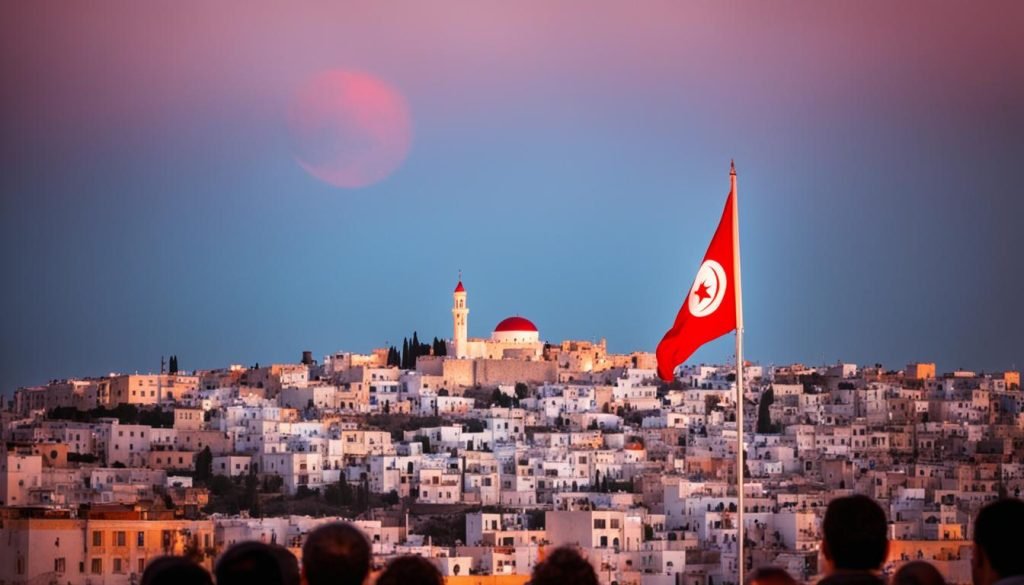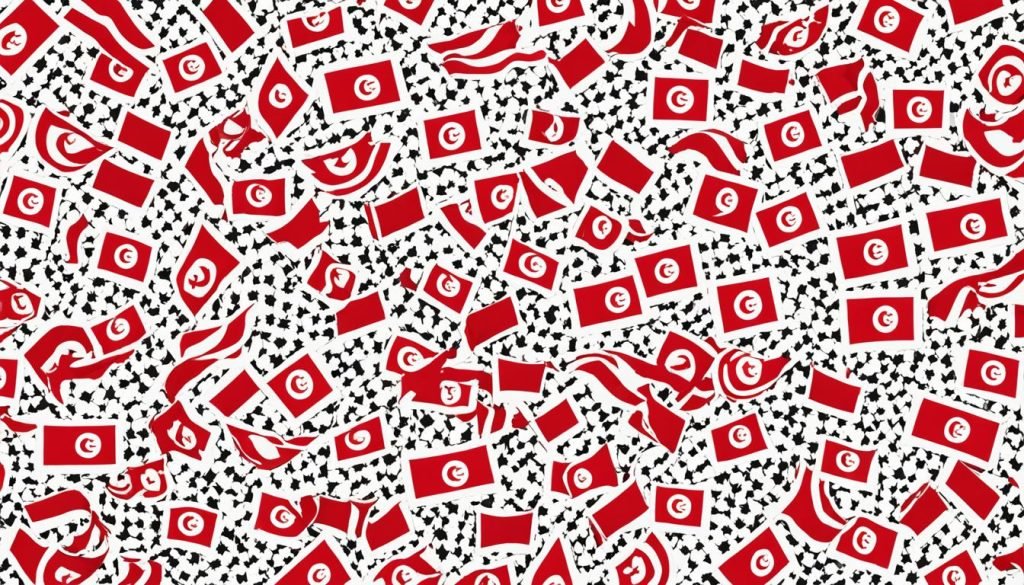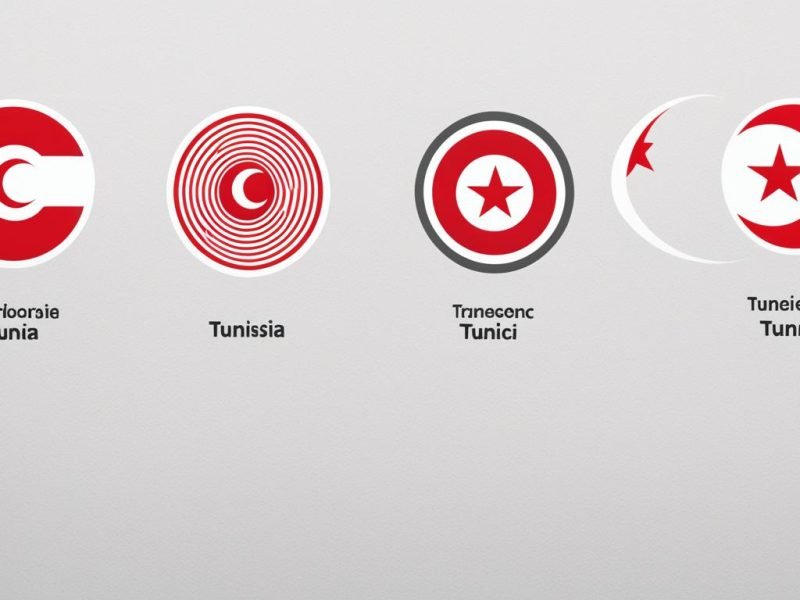I love learning about what national symbols mean. They tell us about a country’s past, tough times, and victories. Tunisia’s flag has a fascinating story. It was made official on October 20, 1827. Since then, it has changed a bit but kept its famous look. It has a white circle with a red moon and star. This shows Tunisia’s rich Islamic culture and good luck.
The look of Tunisia’s flag has changed a bit but always stayed true to its roots. It shows the country’s Islamic background and fight for freedom. Hussein II, Tunisia’s leader, wanted a special symbol after a big battle. Even with changes over time, like being under French control, the flag stayed a key symbol since 1959. Its exact size was decided in 1999, making it a big part of what Tunisia stands for.
The changes to Tunisia’s flag are not just about how it looks. They tell the story of the country over time. I looked back at the symbols and colors that make Tunisia special. It’s like seeing the nation’s spirit in its red flag.
Key Takeaways
- The Tunisian flag was officially adopted in 1827 following a key naval conflict.
- Features significant Islamic symbols which have been associated with Tunisia’s heritage.
- Despite periods of foreign control, the flag has been a constant marker of national sovereignty.
- The design was formally integrated into Tunisia’s constitution in 1959 and legalized in 1999.
- The flag is a testament to the country’s historical resilience and cultural continuity.
The Historical Journey of the Tunisian Flag
Exploring the Tunisian flag’s history shows us Tunisia’s national identity. The design tells of the influences and events that shaped the nation.
Pre-18th Century Maritime Flags of Tunis
Before the 18th century, Tunis’s sea flags often had a crescent. It showed the Islamic faith. They were colorful, with blue, green, red, and white. These colors showed Tunisia’s rich culture. They also hinted at what the Tunisia flag would later stand for.
Flags of the Husainid Dynasty
The Husainid dynasty was important in Tunisia. Then, the flag changed a lot. The ruler’s flag had blue, red, and green stripes. Each color was chosen for its meaning. It had the Zulfiqar sword and stars on it too. These stood for strength and guidance.
Symbolism in Early Tunisian Flags
Early flags in Tunisia under the Husainid had important symbols. The crescent and stars were key parts. They have stayed important in the flag’s design. This adds deep history and culture to the flag’s creation.
| Element | Symbolic Meaning | Historical Significance |
|---|---|---|
| Crescent and Star | Islamic faith and guidance | Long-standing symbols in regional history |
| Red Color | Courage and Strength | Represents the blood of martyrs |
| White Color | Peace and Purity | Aspirations for peace across the nation |
The colors and symbols of the Tunisian flag tell the nation’s story. They show Tunisia’s spirit and long-lasting heritage.

Origins and Adoption of the Modern Tunisian Flag
Tunisia’s flag story is linked with its history and identity. Its red and white colors and the crescent and star came about in the 19th century. This was when Muslim countries used red on their flags to show unity.
After the 1827 Battle of Navarino, the Tunisian leader, Hussein II, wanted a unique symbol. He aimed for a flag that showed Tunisia’s Islamic roots and freedom. This idea led to Tunisia’s flag in the early 19th century during a time of change.
The crescent and star on the flag go way back, before the Ottoman Empire. They connect the flag to Tunisia’s deep cultural and religious history. This link shows how Tunisia’s past shapes its present.
Let’s look at this timeline to understand the flag’s history:
| Event | Year | Significance |
|---|---|---|
| Battle of Navarino | 1827 | Triggered the move towards a unique Tunisian flag |
| Official Adoption of Red Background | Early 19th Century | Aligned with Ottoman naval ensign standards |
| Integration of Crescent and Star | 19th Century | Symbolizes Islamic heritage and Tunisian culture |
The Tunisian flag’s history is not just about how it looks. It is a story of unity and pride. It shows how the nation has come together under one flag.
Significance of the Red and White Colors
The Tunisian flag colors of red and white are full of meaning. The color red stands for the brave blood shed to protect Tunisia. This goes back to a big fight with Turkey in 1574. White shows a wish for peace and symbolizes the country’s hopes for unity and freedom.
These colors show the strong spirit of the nation. Through time, no matter the changes, they keep showing Tunisia’s true identity. They tell of a spirit that lasts forever.
The Tunisian flag colors also show the country’s Islamic faith. The white circle in the middle has a crescent and a star in red. This shows a bond with Muslims everywhere. It speaks of community and faith in Tunisian life.
The red and white of our flag does not merely cover the surface of a banner. It enshrines the essence of our past struggles and our peaceful hopes for the future.
- Red: Reflects the valor and sacrifices in Tunisian history.
- White: Symbolizes peace, purity, and unity.
- Crescent and Star: Represents Islamic identity and solidarity.
| Color | Symbolism | Historical Significance |
|---|---|---|
| Red | Valor, Sacrifice | Protection of the nation, Conflict of 1574 |
| White | Peace, Unity | Aspirations for freedom and harmony |

Tunisia Under French Protection: A Flag Unchanged
In 1881, Tunisia became a French protectorate. This was a key time for the Tunisian flag’s history. Even under French control, the Flag of Tunisia kept its meaning of national identity. My look into this time shows how the flag helped keep Tunisia’s spirit alive.
French Influence on National Symbols
French culture and politics influenced Tunisian life back then. But, the Tunisian flag stayed the same in design. While other symbols changed, the flag’s red and white and its emblems stayed true. They showed the country’s deep roots and freedom.
Continuity of the Tunisian Flag Design
The flag’s story is one of never giving up. There were times the French flag appeared with Tunisia’s symbols on buildings. But, no big changes were made to the Tunisian flag. It remained a strong symbol of identity through French control to independence in 1956. This flag is a powerful reminder of Tunisia’s long history and enduring spirit.







